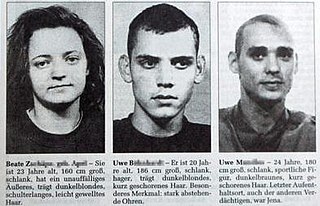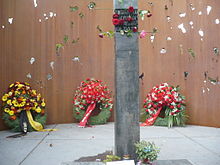In the United States, domestic terrorism is defined as terrorist acts that were carried out within the United States by U.S. citizens and/or U.S. permanent residents. As of 2021, the United States government considers white supremacists to be the top domestic terrorism threat.

Right-wing terrorism, hard right terrorism, extreme right terrorism or far-right terrorism is terrorism that is motivated by a variety of different right-wing and far-right ideologies. It can be motivated by Ultranationalism, neo-Nazism, anti-communism, neo-fascism, ecofascism, ethnonationalism, religious nationalism, anti-immigration, anti-semitism, anti-government sentiment, patriot movements, sovereign citizen beliefs, and occasionally, it can be motivated by opposition to abortion, tax resistance, and homophobia. Modern right-wing terrorism largely emerged in Western Europe in the 1970s, and after the Revolutions of 1989 and the dissolution of the Soviet Union in 1991, it emerged in Eastern Europe and Russia.

Gundolf Köhler was a German far-right terrorist who planted a bomb at the 1980 Oktoberfest in Munich, killing 13 people and injuring more than 200 in what is known as the Oktoberfest bombing.

Oktoberfest is the world's largest Volksfest, featuring a beer festival and a travelling carnival, and is held annually in Munich, Bavaria, from mid- or late-September to the first Sunday in October, with more than six million international and national visitors attending the event. Locally, it is called d'Wiesn, after the colloquial name for the fairgrounds, Theresienwiese. Oktoberfest is an important part of Bavarian culture, having been held since the year 1810. Other cities across the world also hold Oktoberfest celebrations that are modeled after the original Munich event.

The far-right in Germany slowly reorganised itself after the fall of Nazi Germany and the dissolution of the Nazi Party in 1945. Denazification was carried out in Germany from 1945 to 1949 by the Allied forces of World War II, with an attempt of eliminating Nazism from the country. However, various far-right parties emerged in the post-war period, with varying success. Most parties only lasted a few years before either dissolving or being banned, and explicitly far-right parties have never gained seats in the Bundestag post-WWII.
Heinz Lembke was a German right-wing extremist and a member of the stay-behind network Gladio. Lembke was found hanged in his prison cell one day before his hearing by the federal prosecutor.

The National Socialist Underground murders were a series of racist murders by the German Neo-Nazi terrorist group National Socialist Underground. The NSU perpetrated the attacks between 2000 and 2007 throughout Germany, leaving ten people dead and one wounded. The primary targets were ethnic Turks, though the victims also included one ethnic Greek and one ethnic German policewoman.

The National Socialist Underground, or NSU, was a German neo-Nazi militant organization active between 2001 and 2010, and uncovered in November 2011. Regarded as a terror cell, the NSU is mostly associated with Uwe Mundlos, Uwe Böhnhardt and Beate Zschäpe, who lived together under false identities. Between 100 and 150 further associates were identified who supported the core trio in their decade-long underground life and provided them with money, false identities and weapons. Unlike other terror groups, the NSU had not claimed responsibility for their actions. The group's existence was discovered only after the deaths of Böhnhardt and Mundlos, and the subsequent arrest of Zschäpe.

Germany has experienced significant terrorism in its history, particularly during the Weimar Republic and during the Cold War, carried out by far-left and far-right German groups as well as by foreign terrorist organisations.

The NSU trial or National Socialist Underground trial was a trial in Germany against several people in connection with the National Socialist Underground (NSU) – an extreme-right terrorist organization – and the NSU murders. It took place between 6 May 2013 and 11 July 2018 in Munich before the Munich Higher Regional Court. The trial was notable for being one of the largest, longest and most expensive in German history and made public claims of institutionalized racism within the German police force who for years ruled out Neo-Nazis as potential suspects in the killings and instead focused on suspects with Turkish backgrounds," going so far as to name their investigation "Bosporus."

There is a long history of terrorism in Europe. This has often been linked to nationalist and separatist movements, while other acts have been related to politics, religious extremism, or organized crime. Terrorism in the European sections of the intercontinental countries of Turkey and Russia are not included in this list.

On 22 July 2016, a mass shooting occurred in the vicinity of the Olympia shopping mall in the Moosach district of Munich, Germany. An 18-year-old Iranian-German, David Sonboly, opened fire on fellow teenagers at a McDonald's restaurant before shooting at bystanders in the street outside and then in the mall itself. Nine people were killed, and 36 others were injured, four of them by gunfire. Sonboly then hid nearby for more than two hours, and killed himself by a self-inflicted gunshot wound when confronted by police.

On 11 April 2017, the tour bus of the German football team Borussia Dortmund was attacked with roadside bombs in Dortmund, Germany. Three bombs exploded as the bus ferried the team to the Westfalenstadion for the first leg of their quarter-final against Monaco in the UEFA Champions League. One of the team's players, Marc Bartra, and a policeman were wounded, but the strengthened windows of the bus prevented casualties.

Peter-Herbert Frank is a German jurist who is currently serving as a judge in the Federal Constitutional Court in the second senate. Prior to this, he served as Public Prosecutor General and as Attorney General for the Higher Regional Court of Munich.

The Halle synagogue shooting occurred on 9 October 2019 in Halle, Saxony-Anhalt, Germany, and continued in nearby Landsberg. After unsuccessfully trying to enter the synagogue in Halle during the Jewish holiday of Yom Kippur, the attacker, 27-year-old Stephan Balliet, fatally shot two people nearby and later injured two others. Federal investigators called the attack far-right and antisemitic terrorism.
The Hepp-Kexel-Group was a right-wing terroristic gang in West-Germany. The gang perpetrated bank robberies and attacks in the early 1980s; its members came from the main far-right terrorist gang of this time, the Wehrsportgruppe Hoffmann. The Hepp-Kexel group was until the self-release of the NSU as the most important right-wing terrorist group in the Federal Republic of Germany.

The Hanau shootings occurred on 19 February 2020, when eleven people were killed and five others wounded in a terrorist shooting spree by a far-right extremist targeting a shisha bar, a bar and a kiosk in Hanau, near Frankfurt, Hesse, Germany. After the attacks, the gunman returned to his apartment, where he killed his mother and then committed suicide. The massacre was called an act of terrorism by the German Minister of Internal Affairs.
On 24 February 2020, a man rammed his car against a crowd at a carnival parade in Volkmarsen, Hesse, Germany, injuring 88 people. In total, 150 people were considered "negatively affected or traumatized by the incident", and it was later described to the courts as a "miracle" that no one had been killed. The attack came only days after a terrorist attack in Hanau.
Uwe Behrendt was a German far-right extremist. In 1976 he became de facto deputy leader of the "Wehrsportgruppe Hoffmann" (WSG-Hoffmann), a network of between 400 and 600 politically like-minded activists and terrorists which concealed its underlying mission, rather unconvincingly, by presenting itself as a paramilitary sports club. Behrendt was widely considered as the group member closest in terms of (informal) seniority and personal support to the leader, Karl-Heinz Hoffmann. He came to wider attention because of a notorious double murder and questions posed by the subsequent handling of it when, on 19 December 1980, believed to have been motivated by antisemitic race-based hatred, Behrendt murdered a rabbi-publisher called Shlomo Lewin and Lewin's life-partner, Frida Poeschke in Erlangen. From the perspective of the German legal system, no one was ever convicted in connection with the murder. Behrendt was able to escape to Lebanon where, following further controversy involving allegations of torture and more killing, he is believed to have committed suicide in 1981.
Olivia Jane Frank (1956–2023) was a transgender woman who served as an Israel Defense Forces officer and became an intelligence agent for the Mossad after being recruited by David Kimche. She infiltrated the Abu Nidal Organization and assisted in the pursuit of the perpetrators and accomplices of the Munich massacre.
















